Hendrick Martensz. Sorgh stands as a significant figure among the painters of the Dutch Golden Age, a period of extraordinary artistic flourishing in the 17th-century Netherlands. Active primarily in Rotterdam, Sorgh carved a niche for himself with his detailed and engaging depictions of everyday life. His canvases offer valuable glimpses into the interiors, markets, and social interactions of his time, rendered with a characteristic blend of realism, careful composition, and often, a subtle narrative quality. While perhaps not as universally renowned as contemporaries like Rembrandt or Vermeer, Sorgh's contribution to the rich tapestry of Dutch genre painting is undeniable and merits close examination.
Origins and Early Life in Rotterdam
Hendrick Maertensz. Sorgh was born in the bustling port city of Rotterdam. While historical records present some ambiguity regarding his exact birth year, scholarly consensus leans towards approximately 1611, although dates like 1609 have also been suggested. His given surname was actually Rokes (or Rochus). The name "Sorgh," by which he is known, is believed to have originated as a nickname for his father, Maerten Claesz. Rokes. The elder Rokes operated a market barge, transporting goods, likely including produce and other wares, between Rotterdam and Dordrecht. Tradition holds that his careful and diligent handling of this cargo earned him the moniker "Sorgh," derived from the Dutch word zorgvuldig, meaning careful or conscientious. This nickname was subsequently adopted by his son, the painter.
Growing up in Rotterdam, a major hub of trade and maritime activity, would have exposed the young Hendrick to a vibrant cross-section of Dutch society. The city's markets, docks, taverns, and domestic interiors provided a rich source of visual inspiration that would later manifest prominently in his artwork. His mother hailed from Antwerp, linking the family to another major artistic center in the Low Countries, though Hendrick's career remained firmly rooted in Rotterdam. This environment, combining mercantile energy with domestic life, formed the backdrop against which his artistic sensibilities developed.
Artistic Training and Formative Influences
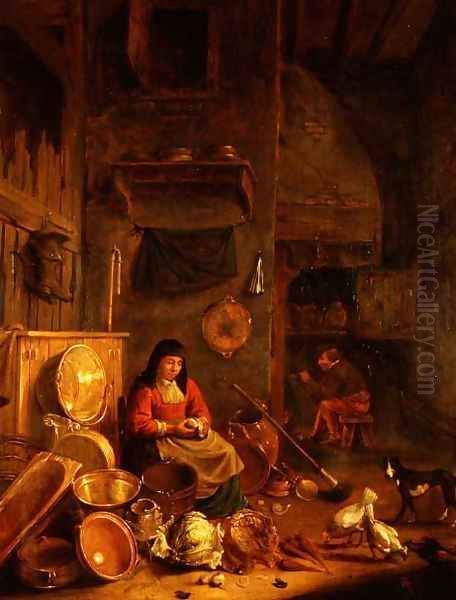
Sorgh's formal artistic training connected him to notable figures in the Dutch and Flemish art scenes. Sources indicate that he studied under two distinct masters. One was David Teniers the Younger, a highly successful and prolific Flemish painter based primarily in Antwerp and Brussels. Teniers was renowned for his peasant scenes, tavern interiors, and landscapes, executed with technical skill and often a lively, anecdotal quality. While the exact nature and duration of Sorgh's time with Teniers isn't fully documented, the influence of Teniers' detailed genre scenes can be discerned in Sorgh's own work.
His other documented teacher was Willem Pieterszoon Buytewech, a prominent artist active in Rotterdam during Sorgh's youth. Buytewech, known as "Gheestige Willem" (Witty Willem), was a master of elegant interior scenes featuring fashionable young people, as well as being a talented etcher and draftsman. Buytewech's influence might be seen in Sorgh's compositional arrangements and his interest in depicting social gatherings, albeit often featuring less aristocratic subjects than Buytewech typically portrayed.
Beyond his direct teachers, Sorgh's style was significantly shaped by the broader artistic currents of the time, particularly the work of Adriaen Brouwer. Brouwer, though Flemish by birth, spent crucial years working in the Northern Netherlands and profoundly impacted Dutch genre painting with his raw, expressive depictions of peasant life, particularly tavern brawls and drinking scenes. Sorgh adopted Brouwer's interest in low-life themes but generally rendered them with a calmer, more detailed, and less turbulent approach. The influence of Rotterdam-based contemporaries like Pieter de Bloot and Cornelis Saftleven, who also specialized in genre subjects, likely played a role as well.
A Career Rooted in Rotterdam
Hendrick Sorgh spent the entirety of his professional life in his native Rotterdam. He established himself as a respected member of the city's artistic community. Evidence of his standing comes from his involvement in the local Guild of Saint Luke, the professional organization for painters and other craftsmen. In 1654, he achieved the position of hoofdman, or headman, of the Guild, indicating the esteem in which his peers held him. This role would have involved administrative duties and upholding the standards of the profession within the city.
His clientele likely consisted of the burgeoning middle class of Rotterdam – merchants, professionals, and prosperous citizens who sought artworks to decorate their homes. The themes Sorgh specialized in – domestic interiors, market scenes, and depictions of everyday activities – resonated well with this audience, reflecting their own lives and values. While large-scale commissions for public buildings or the highest echelons of society might have been less frequent for a genre painter like Sorgh, the private market for cabinet-sized pictures was robust during the Golden Age.
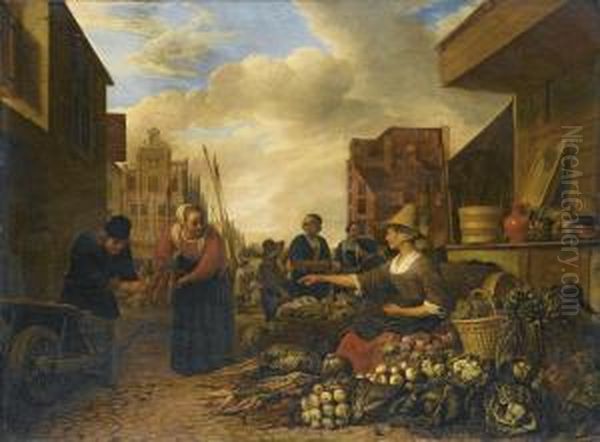
Some accounts mention Sorgh working for a linen merchant named Justus de La Grange around 1650, possibly in a capacity described as both painter and servant. This arrangement seems unusual for an established master and Guild headman and might reflect a specific patronage agreement, a series of commissions, or perhaps a temporary situation. Regardless, it highlights the diverse ways artists navigated the economic landscape of the time. Sorgh remained active as a painter in Rotterdam until his death. He was buried in the city on June 28, 1670.
Diverse Subject Matter: A Mirror to Society
Sorgh's oeuvre is characterized by its thematic diversity, though certain subjects recur frequently, showcasing his particular interests and skills. His depictions of interior scenes, especially kitchens and domestic spaces, are among his most characteristic works. These paintings often feature a wealth of meticulously rendered objects – copper pots, earthenware jugs, baskets of vegetables, hanging game – creating a strong sense of verisimilitude. He masterfully captured the play of light within these spaces, illuminating textures and defining forms.
Market scenes form another significant category in his work. Paintings like A Vegetable Market or fish markets capture the lively bustle of commerce. Sorgh populated these scenes with vendors, shoppers, and onlookers, creating dynamic compositions filled with anecdotal detail. These works not only showcase his skill in rendering diverse textures and goods but also provide valuable documentation of contemporary trade and social interaction in urban settings. His approach echoes, in some ways, the earlier market and kitchen pieces pioneered by artists like Pieter Aertsen and Joachim Beuckelaer in the 16th century, but adapted to the tastes and scale of 17th-century Dutch homes.
Peasant and tavern scenes also feature prominently, reflecting the influence of Brouwer and Teniers. Sorgh depicted farmers drinking, smoking, playing cards, or simply conversing in rustic interiors. Compared to Brouwer's often chaotic and visceral portrayals, Sorgh's scenes tend to be more orderly and observed, sometimes imbued with a gentle humor or a quiet sense of camaraderie. These works catered to the urban fascination with rural life, a common theme in Dutch Golden Age art.
Less common, but still present, are Sorgh's marine paintings and historical or biblical subjects. His seascapes often depict ships near the shore or in estuaries, reflecting Rotterdam's identity as a major port. His handling of historical and religious themes is particularly interesting, as he often integrated these narratives into familiar genre settings. For instance, a biblical story might unfold within a contemporary Dutch interior, blurring the lines between the sacred and the everyday.
Signature Works: Highlights of Sorgh's Art
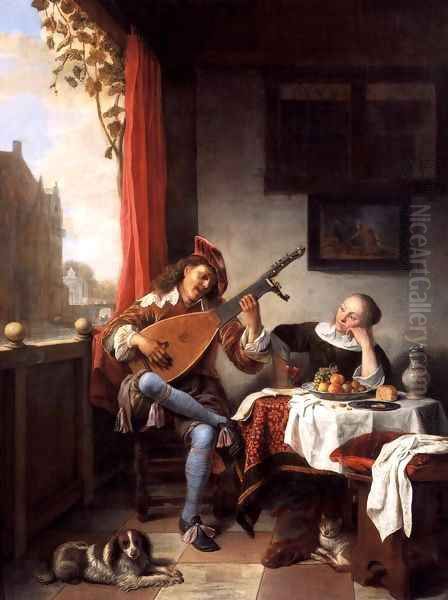
Several paintings stand out as representative examples of Hendrick Sorgh's artistic achievements. A Kitchen Interior, housed in various versions and adaptations across collections, exemplifies his mastery of the domestic scene. These works typically showcase a brightly lit kitchen space, often with a female figure engaged in chores, surrounded by an abundance of carefully painted still-life elements. The attention to detail in rendering textures – the gleam of metal, the roughness of pottery, the softness of fabrics – is remarkable. Light often streams in from a window, creating convincing spatial depth and highlighting specific areas.
A Man Writing (or similar titles depicting scholars or merchants at their desks) shows Sorgh's ability to capture quieter, more contemplative moments. These interiors focus on solitary figures absorbed in their work, surrounded by the attributes of their profession – books, documents, globes. The mood is often intimate and focused, demonstrating his versatility beyond bustling market or kitchen scenes.
His Vegetable Market paintings are vibrant examples of his skill in handling complex, multi-figure compositions. They depict the lively exchange between vendors and customers, showcasing a colorful array of produce. These works capture the energy of urban life and demonstrate Sorgh's keen observation of social dynamics and his ability to orchestrate a busy scene effectively.
A particularly notable work is Christ at Emmaus. While depicting a significant biblical event – the resurrected Christ revealing himself to two disciples – Sorgh often sets the scene within what appears to be a contemporary Dutch kitchen or inn. This integration of the sacred into a familiar, everyday environment was a characteristic approach for some Dutch artists, making the religious narrative more relatable and immediate to the viewer. It highlights Sorgh's ability to handle historical subjects with originality.
The Portrait of the Bierens Family (1663) is an interesting example of group portraiture combined with a genre setting. It depicts the family gathered in a large kitchen, seemingly engaged in preparing a meal together. This informal approach contrasts with more rigid, formal group portraits of the era and aligns with Sorgh's strength in depicting domestic activities, blending portraiture with his preferred genre elements.
Artistic Style and Technique
Hendrick Sorgh's style is characterized by a commitment to detailed realism, typical of much Dutch Golden Age painting. He rendered objects, textures, and surfaces with meticulous care, creating a tangible sense of the physical world. His brushwork is generally smooth and controlled, allowing for fine detail without becoming overly fussy or distracting from the overall composition. This careful finish appealed to the Dutch taste for fijnschilder-like precision, although his work is often more robust and less miniaturist than that of Leiden masters like Gerard Dou.
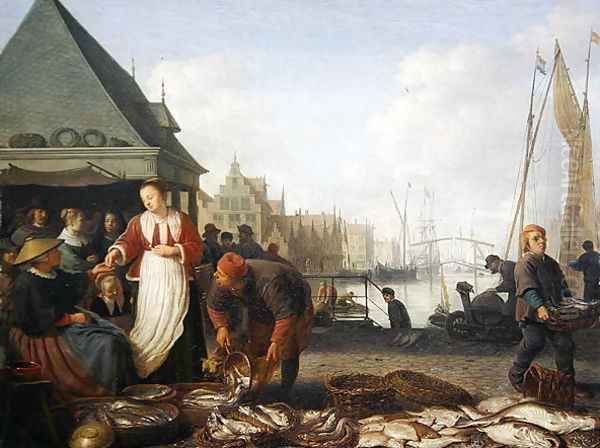
His handling of light and shadow is a key feature of his interiors. He often used directed light sources, such as windows or doorways, to illuminate parts of the scene while leaving other areas in soft shadow. This creates a convincing sense of volume and space, guiding the viewer's eye through the composition. In his market scenes, the light is typically brighter and more diffuse, appropriate for an outdoor setting, contributing to the overall sense of liveliness.
Sorgh's compositions are carefully constructed, often using architectural elements like doorways, windows, and receding floor tiles to create perspective and depth. Figures are typically arranged naturally within the space, engaged in believable activities and interactions. While his scenes can be busy, especially the markets, they rarely feel chaotic, maintaining a sense of underlying order.
His palette varied depending on the subject. Interiors often feature warm earth tones – browns, ochres, reds – creating a cozy, domestic atmosphere. Market scenes, by contrast, frequently employ brighter, more varied colors to depict the array of goods and the vibrancy of the crowd. Throughout his work, there is a strong narrative element; his paintings often tell a small story or capture a specific moment in time, inviting the viewer to engage with the depicted scene and its inhabitants.
Personal Life and Connections
Beyond his artistic career, Hendrick Sorgh was integrated into the social fabric of Rotterdam. A significant event in his personal life was his marriage on February 20, 1633, to Adriaantje Hollaer. She was the daughter of Pieter Jacobs Hollaer, a merchant, suggesting a marriage that connected Sorgh to the prosperous bourgeois class that likely formed a core part of his clientele.
Adriaantje Hollaer holds a particular place in art history due to a connection with one of the era's greatest masters, Rembrandt van Rijn. Rembrandt painted a portrait of Adriaantje Hollaer around 1647 (now in the Fogg Museum, Harvard University). He also painted a portrait of her father, Pieter Hollaer. These portraits were likely commissioned independently and attest to the Hollaer family's status and ability to commission work from the leading portraitist of the day. This connection, though indirect, places the Sorgh household within the orbit of the wider Dutch art world and its prominent figures. Hendrick and Adriaantje had at least one son, Maerten Sorgh, who reportedly also became a painter, although little is known about his work.
Sorgh in the Context of the Dutch Golden Age
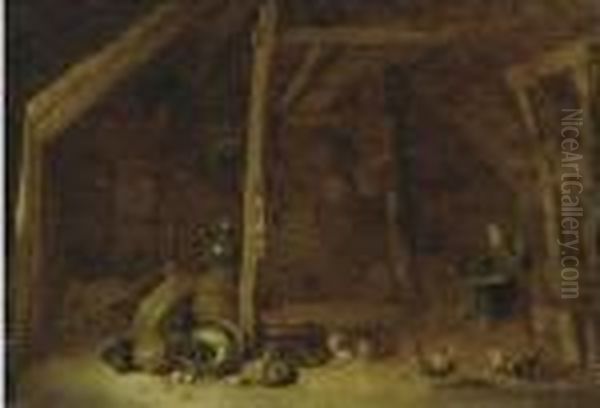
To fully appreciate Hendrick Sorgh's work, it is essential to place him within the context of the Dutch Golden Age. The 17th century saw the Dutch Republic rise to become a major economic and maritime power. This prosperity fueled an unprecedented boom in the art market. Unlike in Catholic countries where the church and aristocracy were the primary patrons, Dutch art was largely commissioned and purchased by a wealthy merchant class and prosperous citizens.
This shift in patronage led to a demand for new types of subjects that reflected the interests and values of this clientele. Genre painting – scenes of everyday life – became immensely popular. Artists specialized in various sub-genres: domestic interiors, tavern scenes, street life, markets, portraits of civic groups, landscapes, seascapes, and still lifes. Sorgh operated squarely within this trend, focusing on themes that resonated with the experiences and aspirations of his middle-class patrons.
His work embodies several key characteristics of Dutch Golden Age art: a focus on realism and detailed observation, an interest in depicting contemporary life, the skillful rendering of light and texture, and often, an underlying moral or anecdotal message. Rotterdam, as his base, was a dynamic city, less dominant as an art center than Amsterdam, Haarlem, or Delft, but possessing its own distinct community of artists, including figures like Cornelis Saftleven, Pieter de Bloot, Ludolf de Jongh, and Herman Saftleven (Cornelis's brother), contributing to the overall richness of Dutch art.
Contemporaries and Comparisons
Sorgh worked during a period populated by numerous talented genre painters, and comparing his work to theirs helps define his specific contribution. His teacher, David Teniers the Younger, while Flemish, shared an interest in peasant life, but Teniers' scenes are often more sprawling and filled with a greater number of figures, sometimes with a silvery tonality distinct from Sorgh's warmer interiors. Willem Buytewech, his other teacher, focused on more elegant, fashionable gatherings, differing from Sorgh's more commonplace subjects.
Adriaen Brouwer's influence is clear in the tavern scenes, but Brouwer's brushwork is typically looser and more expressive, his figures often more caricatured and emotionally charged. Adriaen van Ostade and his brother Isaac van Ostade, working in Haarlem, were also masters of peasant genre. Adriaen van Ostade's work often shares Sorgh's warmth and detail but perhaps with a greater emphasis on the picturesque qualities of rural life.
In Delft, painters like Pieter de Hooch and Johannes Vermeer were creating interior scenes renowned for their tranquil atmosphere and masterful handling of light. While Sorgh also excelled at interiors, his scenes are often busier and more focused on activities like cooking or selling, compared to the serene stillness found in many Delft paintings. Jan Steen, active in Leiden and Haarlem, was another prolific genre painter, known for his lively, often chaotic, and humorous depictions of households and celebrations. Steen shared Sorgh's narrative impulse but often pushed it towards more overt comedy or moralizing.
Other contemporaries exploring similar themes include Gabriel Metsu, known for his highly refined and elegant genre scenes often depicting the upper middle class, and Gerard Dou, the leading figure of the Leiden 'fijnschilders', whose small-scale works are characterized by an almost microscopic level of detail, exceeding even Sorgh's meticulousness. Quiringh van Brekelenkam also painted many quiet domestic interiors and workshop scenes that bear comparison with Sorgh's work. Sorgh's position within this constellation is that of a skilled and versatile painter, particularly strong in depicting the bustling life of kitchens and markets with clarity and engaging detail.
Later Reputation and Legacy
During his lifetime and shortly after, Hendrick Sorgh was a respected and successful artist within Rotterdam. His paintings were collected by local citizens and found their way into inventories of the period. However, in the centuries that followed, his reputation, like that of many competent but not superstar Golden Age painters, was somewhat overshadowed by the towering figures of Rembrandt, Vermeer, Hals, and Steen.
Nevertheless, his work continued to be appreciated by collectors and connoisseurs of Dutch art. His paintings are now found in major museums around the world, including the Rijksmuseum in Amsterdam, the Mauritshuis in The Hague, the National Gallery in London, the Louvre in Paris, and numerous institutions in Germany and the United States. They are valued for their documentary quality, their technical skill, and their charming depiction of 17th-century Dutch life.
A fascinating, albeit indirect, aspect of Sorgh's legacy emerged in the 20th century. The Spanish surrealist master Joan Miró, during a trip to the Netherlands in 1928, was inspired by Dutch Golden Age paintings he saw, particularly works by Sorgh and Jan Steen. This encounter led Miró to create his famous Dutch Interior series, abstract and fantastical reinterpretations of the 17th-century originals. Miró's Dutch Interior II is explicitly based on Sorgh's painting The Lute Player. This connection demonstrates the enduring power of Golden Age imagery and how artists across centuries can find inspiration in unexpected places.
Conclusion: A Valued Painter of Dutch Life
Hendrick Maertensz. Sorgh was a quintessential painter of the Dutch Golden Age. Firmly rooted in his native Rotterdam, he developed a distinctive style characterized by detailed realism, skillful composition, and an engaging approach to depicting everyday life. His paintings of kitchens, markets, taverns, and domestic interiors provide invaluable visual records of his time, rendered with technical proficiency and often imbued with warmth and narrative interest.
While influenced by masters like Teniers, Buytewech, and Brouwer, Sorgh developed his own voice, contributing significantly to the rich genre painting tradition of the Netherlands. His ability to capture the textures of objects, the play of light in interiors, and the bustle of urban commerce marks him as a highly accomplished artist. Though perhaps not ranked among the absolute giants of the era, Sorgh remains a crucial figure for understanding the breadth and depth of Dutch art, his canvases continuing to offer delight and insight to viewers centuries later. His work stands as a testament to the Dutch fascination with their own world and the remarkable artistic talent that flourished during their Golden Age.